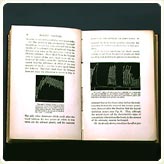 Cannon's "Bodily Changes in Pain, Hunger, Fear and Rage" Cannon's "Bodily Changes in Pain, Hunger, Fear and Rage"
| Time
| 1910 |
| Title
| Walter B. Cannon identifies the brain as the human emotional center |
| Event
| American physician Walter B. Cannon proposes that emotions and bodily arousal are both organized by the brain. This is commonly known as the fight-or-flight response, the body’s first line of defense against danger. Blood rushes to the skeletal muscles and chemicals are dumped into the nervous system. Also well documented is Cannon’s research on the sympathetic nervous system and neurochemical transmission of nerve impulses. |
|
The body and mind (or brain) are intimately linked in Cannon’s work.
|
In Cannon's fight-or-flight theory, if a person senses danger in the form of a wild animal, then bodily arousal, running, and feelings of fear will all be generated at the same time. On a physiological level, seeing an animal activates the thalamus, which in turn alerts both the cortex and the hypothalamus for action. The cortex is responsible for emotional feelings and emotional behavior. The hypothalamus is responsible for arousing the body.
Cannon also discovers the adrenalin-like hormone, sympathin.
|
Spirituality is not cited as an influence in this research. However, Cannon did publish an article describing the clinical features of several cases of Voodoo death, and attempted to explain these in terms of sympathetic nervous system responses.
|
|



